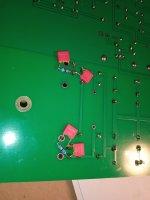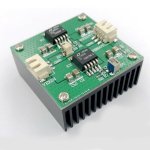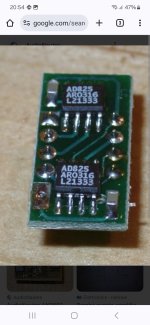Where would a fellow find the most recent data sheets? The onsemi site has a copyright of 2019 for 78/79xx.
7800/7900 series regs are more than 50yr old now. It's as jellybean a part as one could be imagined. The old datasheets are still quite valid.
...however you bought up OnSemi, and their "MC" 7800/7900 series regs are 100% compatible, but looking at her not insignificantly better performance, it's safe to say they are a newer (and likely different) design. My current preference.
...however you bought up OnSemi, and their "MC" 7800/7900 series regs are 100% compatible, but looking at her not insignificantly better performance, it's safe to say they are a newer (and likely different) design. My current preference.
I don't know how much it can affect the sound, but there are 2A schottky diodes in the rectifier, and each secondary has a snubber determined by the Quasimodo tester. That's how I do all the rectifiers now, but I haven't had a chance to compare anything without a snubber and with standard diodes vs. shottky + snubber.
Attachments
There are "super regulators" compatible with 78xx etc.7800/7900 series regs are more than 50yr old now. It's as jellybean a part as one could be imagined. The old datasheets are still quite valid.
...however you bought up OnSemi, and their "MC" 7800/7900 series regs are 100% compatible, but looking at her not insignificantly better performance, it's safe to say they are a newer (and likely different) design. My current preference.
They promise, on paper, better performance but reach a maximum of 1.5A.
Who knows if it will be audible then.
I was thinking about Sparkos 78/79xx regulators for my Whammy but decided against it. Mostly because of the price (around $50 a piece without customs duty), and a little because of the fear that everything doesn't sound too sharp to me, like their opamp.
There are other options as well, but after this first piece, I'm not one to experiment anymore. I'm sorry that I can't use LT1963/LT3015 because of the voltage limit for LT1963 (20V), although I have those regulators and have used them successfully in DIY DAC.
There are other options as well, but after this first piece, I'm not one to experiment anymore. I'm sorry that I can't use LT1963/LT3015 because of the voltage limit for LT1963 (20V), although I have those regulators and have used them successfully in DIY DAC.
Attachments
Last edited:
Hi everyone.
I couldn't resist the temptation to do some op amp rolling.
I had some AD825s and tried them.
I like the sound.
Is it normal for it to be hot?
I can keep my finger on it for a long time but it's hot....
I couldn't resist the temptation to do some op amp rolling.
I had some AD825s and tried them.
I like the sound.
Is it normal for it to be hot?
I can keep my finger on it for a long time but it's hot....
It could be oscillating. How are the power supply pins bypassed? Did you install the optional feedback capacitors C2 and C7?
There is no power supply bypass becouse is not simply to implement and there is no c2 and c7 but if necessari I will try.
I haven't an oscilloscope to see what happens.
I haven't an oscilloscope to see what happens.
Heavens. The opamp is bypassed by C3 and C4 which normally would be enough for a dual opamp, however you have two AD825s in some form of single-to-dual adapter. They're fast opamps so they want higher frequency bypassing, say X7R ceramics of at least 1 uF, preferably 3.3 uF or greater, across C3/C4 on the bottom of the board. If oscillation is still a problem then you might have to solder the caps right on the opamp pins since the adapter displaces them from C3/C4. Placing them will be a problem; you could try removing C3/C4 and soldering a 10 uF ceramic directly from pin 4 to the circuit board's ground side of C4 and another from pin 7 to the board's ground end of C3.
As for C2/C7, I used 100 pF NP0/C0G ceramic. -3 dB at 300 kHz is acceptable.
As for C2/C7, I used 100 pF NP0/C0G ceramic. -3 dB at 300 kHz is acceptable.
AD825 used to be my favourite OPA for two decades, especialy once biased in Class A, they do respond very well to it and sound great. I still have them in my DAC but will change to OPA1656 which is IMHO better. the world has moved on... but biased in Class A its bass is very addictive (if not as accurate).
AD825 shouldn't get hot, if it does there is a problem as raised in the above post. It is a "fast" amp. You need at least to follow the spec sheet and that means 0.1uF between each PS legs and ground, as close as possible to AD825. Of course no harm goind say 10uF or so and 0.01uF space permitting.
Close to AD825 might be a problem as the ground might be far away on some builds. In my DAC for example I had to bring the ground to AD825 with a wire. make sure your wire is low Z, as short as possible and goes from (OPA) ground to the legs of the decoupling caps you will use. yes, it you haven't built a dedicated adaptation board as I did, you are likely to have some strange overboard caps standing around your AD825... or perhaps you can solve that issue adding caps under your main board.
Legs and wires as short as possible...
Good luck
Claude
AD825 shouldn't get hot, if it does there is a problem as raised in the above post. It is a "fast" amp. You need at least to follow the spec sheet and that means 0.1uF between each PS legs and ground, as close as possible to AD825. Of course no harm goind say 10uF or so and 0.01uF space permitting.
Close to AD825 might be a problem as the ground might be far away on some builds. In my DAC for example I had to bring the ground to AD825 with a wire. make sure your wire is low Z, as short as possible and goes from (OPA) ground to the legs of the decoupling caps you will use. yes, it you haven't built a dedicated adaptation board as I did, you are likely to have some strange overboard caps standing around your AD825... or perhaps you can solve that issue adding caps under your main board.
Legs and wires as short as possible...
Good luck
Claude
I already mentioned that with this amplifier there is no OPA rolling without an oscilloscope. 

Hi.
If 0.1uf near the pins can solve it I could scratch under the PCB until I reach the ground and solder the two capacitors there.
If it doesn't heat up anymore could I consider it solved?
It's true, an observation with an oscilloscope would be needed but I don't have one.
The difference between opa2134 and AD825 is so noticeable that it is difficult to give it up.
I like it a lot more, but it's a matter of taste...
If 0.1uf near the pins can solve it I could scratch under the PCB until I reach the ground and solder the two capacitors there.
If it doesn't heat up anymore could I consider it solved?
It's true, an observation with an oscilloscope would be needed but I don't have one.
The difference between opa2134 and AD825 is so noticeable that it is difficult to give it up.
I like it a lot more, but it's a matter of taste...
AD825 used to be my favourite OPA for two decades, especialy once biased in Class A, they do respond very well to it and sound great. I still have them in my DAC but will change to OPA1656 which is IMHO better. the world has moved on... but biased in Class A its bass is very addictive (if not as accurate).
AD825 shouldn't get hot, if it does there is a problem as raised in the above post. It is a "fast" amp. You need at least to follow the spec sheet and that means 0.1uF between each PS legs and ground, as close as possible to AD825. Of course no harm goind say 10uF or so and 0.01uF space permitting.
Close to AD825 might be a problem as the ground might be far away on some builds. In my DAC for example I had to bring the ground to AD825 with a wire. make sure your wire is low Z, as short as possible and goes from (OPA) ground to the legs of the decoupling caps you will use. yes, it you haven't built a dedicated adaptation board as I did, you are likely to have some strange overboard caps standing around your AD825... or perhaps you can solve that issue adding caps under your main board.
Legs and wires as short as possible...
There is an adapter with double AD825 which already mounts the bypass capacitors (SMD).AD825 used to be my favourite OPA for two decades, especialy once biased in Class A, they do respond very well to it and sound great. I still have them in my DAC but will change to OPA1656 which is IMHO better. the world has moved on... but biased in Class A its bass is very addictive (if not as accurate).
AD825 shouldn't get hot, if it does there is a problem as raised in the above post. It is a "fast" amp. You need at least to follow the spec sheet and that means 0.1uF between each PS legs and ground, as close as possible to AD825. Of course no harm goind say 10uF or so and 0.01uF space permitting.
Close to AD825 might be a problem as the ground might be far away on some builds. In my DAC for example I had to bring the ground to AD825 with a wire. make sure your wire is low Z, as short as possible and goes from (OPA) ground to the legs of the decoupling caps you will use. yes, it you haven't built a dedicated adaptation board as I did, you are likely to have some strange overboard caps standing around your AD825... or perhaps you can solve that issue adding caps under your main board.
Legs and wires as short as possible...
Good luck
Claude
Looking at it carefully I understood that you then have to bring the mass there with a cable
Attachments
There is an adapter with double AD825 which already mounts the bypass capacitors (SMD).
Looking at it carefully I understood that you then have to bring the mass there with a cable
For English speakers, "mass" is ground.
HI.
I had tried an AD825 and I liked it, but it got very hot.
So I bought some bypass capacitors.
I also got a Tl072 and an LM833.
I immediately tried the TL072, it is very very pleasant and remains very cold. In my opinion it is more pleasant than the 2134 which I had already tried.
I'll try the 833.
The AD825 with its complications will perhaps remain in the drawer
I had tried an AD825 and I liked it, but it got very hot.
So I bought some bypass capacitors.
I also got a Tl072 and an LM833.
I immediately tried the TL072, it is very very pleasant and remains very cold. In my opinion it is more pleasant than the 2134 which I had already tried.
I'll try the 833.
The AD825 with its complications will perhaps remain in the drawer
The AD825 is a very hi speed device and requires care in its application and use. I assume you used an adapter board and two AD825's as they are single opamps.
I've always rated the TL0 series very highly and still do. The LM833 is another good device but one that is available in two versions, the original LM833-N from TI and also a TI version with a quasi complementary output stage called LM833.
I've always rated the TL0 series very highly and still do. The LM833 is another good device but one that is available in two versions, the original LM833-N from TI and also a TI version with a quasi complementary output stage called LM833.
- Home
- Amplifiers
- Pass Labs
- "WHAMMY" Pass DIY headphone amp guide



